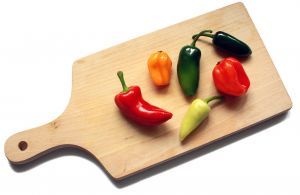Loving hot peppers is an international phenomenon. Just about every region from Thailand, Mexico, China, India, Lebanon, the West Indies and more find a place in their hearts and in their spice cabinets for these potent little bombs. They are carried by mailmen fending off vicious dogs and are even under investigation by the Indian government as a weapon against terrorists. This amazing fruit has even been shown to reduce arthritis pain and inflammation and is incorporated into many over the counter liniments and spicy dishes consumed by sufferers.
But what are they, and should they find a place in your home, medicine cabinet or key chain? And more to the point, how can you enjoy the bite yourself without being too badly bitten?
Hot peppers are members of the genus, Capsicum and the family Solanacea. Every hot pepper from the mildest, through those called, “Gringo Killers” to the hottest industrial grade peppers being investigated by the Indian military to drive terrorists out of caves are all brother and sister capsicums. But their kissing cousins, in the Solanacea family, known in English as the “Nightshades” are stranger still.
The Nightshades sound like a name out of Shakespeare’s Macbeth and like the deadly sisters of yore, they have laid many in their graves. The city and state parks of the mid-Atlantic region harbor at least 3 different species any knowledgeable gardener can instantly identify including the aptly named, “Deadly Nightshade.” These are the pretty plants that look something like a tomato with small white, yellow or purple flowers. They harbor the bright red and very toxic berries that your mother slapped out of your hands the first time she saw them. And well she should, they can kill.
These are just a few of the plants that are among the most deadly in the world. Others include the acutely toxic Jerusalem Cherry, Solanum pseudocapsicum commonly grown as an ornamental which sports round, tomato-like fruits and the viciously spiny, Purple Devil, Solanum atropurpureum which was recently a starring player in the Brooklyn Botanic Garden’s wicked plants exhibit.
But the Nightshades are a truly paradoxical family since they are the source of many of the most beloved and valuable vegetables in the world, including potatoes, tomatoes, bell peppers and egg plants. In fact, it has been said, that the early American Colonists studiously avoided eating tomatoes because of the botanical relationship. Potatoes, imported to Europe by Sir Walter Raleigh from South America suffered no such stigma in spite of a similar relationship and became the primary foodstuff of the Irish peasantry to tragic result later when a potato blight destroyed the crop during the mid-nineteenth century changing history and emptying a county of half its population.
If you wish to grow your own, now is the time to start. Select your heat. Perhaps the mild Bell Pepper, Capsicum annuum, is more your speed, but if you want to live on the wild side, you can choose from Mexican, Thai and Chinese peppers. All available now in garden shops as starters or seeds for your convenience. You should consult a professional since there are literally hundreds of these plants and they range from the tame to things that can put you in a hospital.
Scofield units measure the heat of a particular pepper. The scale ranges from Bells, Banana Peppers and Pimentos whose heat is “0” units to pure capsacin that measures 15 to 16 million units. For comparison, the blinding pepper spray used against robbers and aggressive canines clocks in at 2 to 3 million units, while police use a special spray containing a devastating 5,300,000 units.
The anti-terrorist weapon under investigation by the Indian Military is the bhut jolokia variety which cooks up an astounding 1 million units, compared to the fiery jalapeno pepper that only packs an 8,000 Scofield unit punch. Brown, Orange and Red Savina Habanero Chilies also known as “Gringo Killers” and the infamous Scotch Bonnets measure between 150,000 and 575,000 units. Although not military grade, any of these can send the ignorant straight to a doctor. These 3 are among the hottest varieties grown for human consumption.
The heat of a given pepper will depend both on the variety cultivated and growing conditions so that the values are only approximate. When growing or cutting these, make liberal use of gloves and running water and soap. The oils on the skin should never enter your eyes. Know that the membranes and seeds of these are the hottest part of the pepper so removing them before cooking or avoiding them when eating can be wise precautions.
Although most of us enjoy our peppers with a cold beer, the most effective ways to tame heat include fat rich foods such as whole milk, sour cream and cheese which can coat the mouth and stomach and soothe burns. Never take water to quench a chili burn since this will spread the oil around without extinguishing the flame. All knowledgeable cooks serve these dishes with bread and rice since these two foods also are effective flame retardants.
Although overuse of these foods upset stomachs and cause the green apple quickstep, they are also very helpful in alleviating joint pain and easing sinus pressure and headaches when eaten or as a topical rub. Chinese folk medicine makes extensive use of these plants. In their tradition many maladies are caused by “cold” humors for which the remedy is lots of heat. These plants are also used in the subcontinent of India as Aryuvedic medicine alongside other heat producing spices such as ginger and turmeric.
Food, medicine and weapon, peppers are found wherever people are. Whether mild or manic, peppers will always have a place in your heart or maybe in your glove compartment-right next to the Mace.
Sources:
http://network.nationalpost.com/NP/blogs/theappetizer/archive/2010/03/24/food-fight-india-unveils-its-new-anti-insurgency-weapon-160-hot-peppers.aspx
http://howtogrowhotpeppers.com/index.1.htm
http://www.nlm.nih.gov/medlineplus/ency/article/002871.htm
http://ushotstuff.com/Heat.Scale.htm



